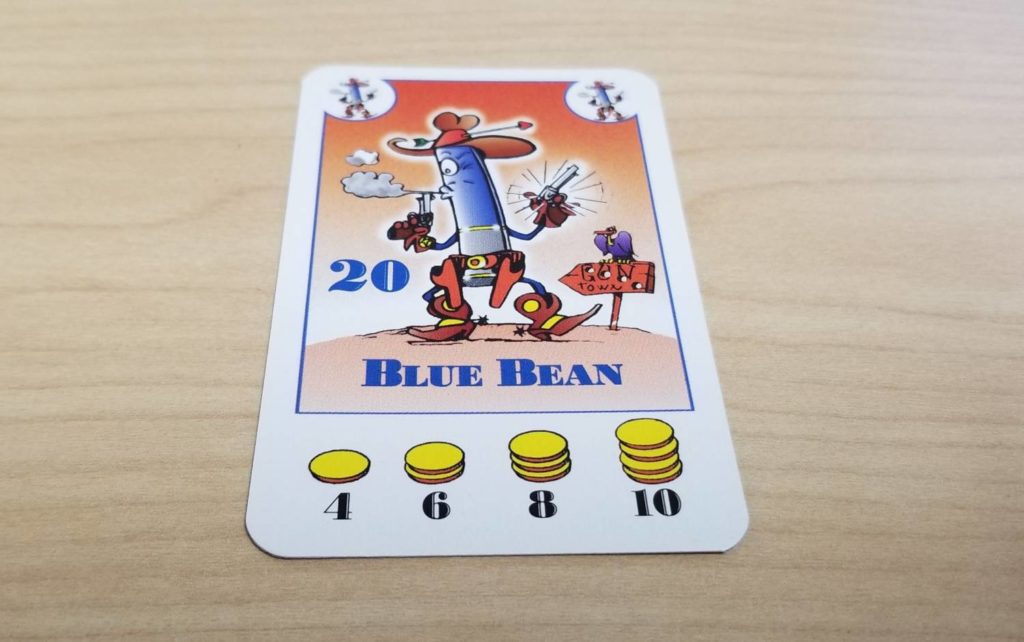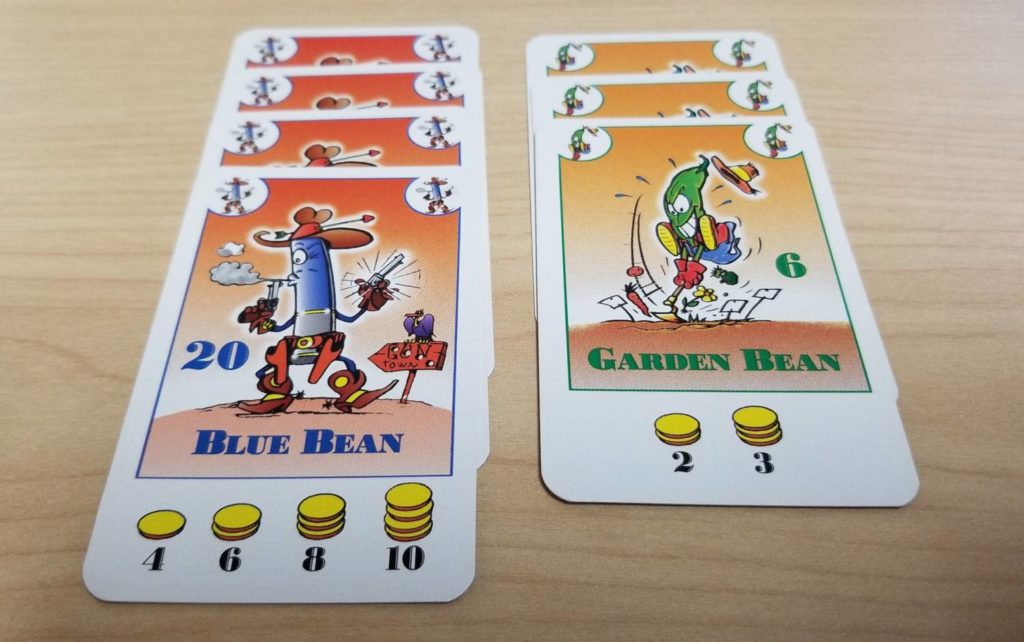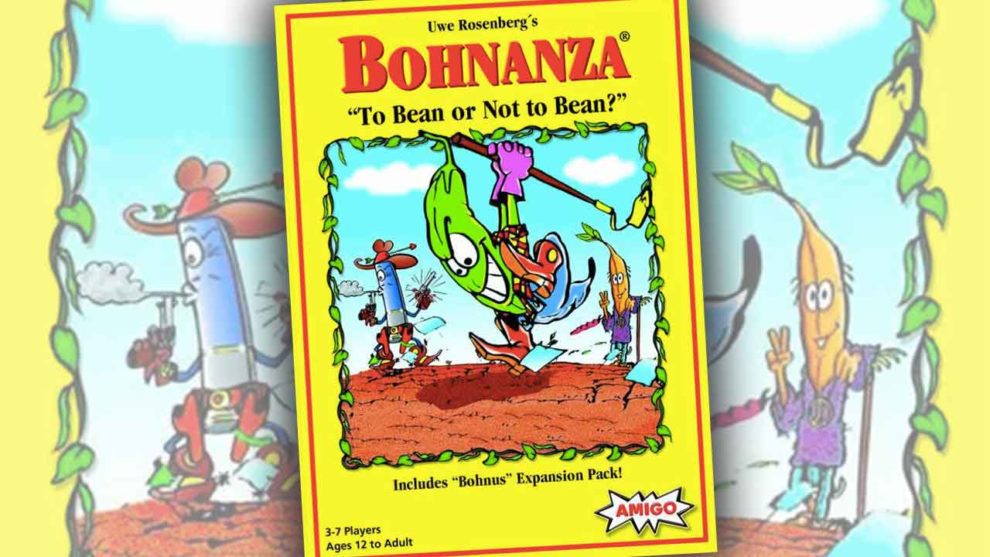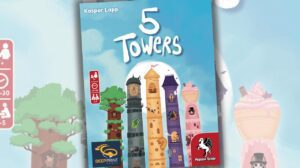In 1997, Uwe Rosenberg teamed up with the publisher AMIGO to launch an empire. An empire built on beans.
It wasn’t Rosenberg’s first design effort, but it was his first to get picked up by a publisher, and it was a smash hit. It was so well received, in fact, that it was nominated for the prestigious Spiel des Jahres that same year. If Uwe Rosenberg wasn’t on publishers’ radars at that point, he certainly was now.
There’s no denying that Uwe’s masterpiece Bohnanza is a juggernaut. In the 20+ years since its initial release, Bohnanza has spawned multiple expansions, spin-offs, and rethemes. It’s even been redesigned into different formats: the board game version, Bean Trader, in 2002 and the card and dice version, Würfel Bohnanza (later re-released as Bohnanza: Das Würfelspiel in 2022), in 2012. Surprisingly, Bohnanza hasn’t received the roll and write treatment yet, but if you ask me, it’s just a matter of time.
In Bohnanza, you’re a bean farmer tending to your crops, trying to harvest them when the time is right for the greatest profit. If you’re able to earn more coins than your competitors before the game’s end, you win.
Setup
A game of Bohnanza is set up thusly:

Shuffle all the Bean cards into a face down deck and then deal five cards to each player. The players then take the cards into their hands without changing their order. This concept is so critical that it bears repeating:
The order of the cards in a player’s hand may never be changed. Never.
And that is literally the entire setup. After selecting a start player by some means, you’re ready to begin playing Bohnanza.
On Your Turn
On your turn, you must plant the first card from your hand into one of your two bean fields (i.e. your playing area). If you do not have two bean fields, then you can add to an existing one (more on this later) if there’s one there OR you can create a second bean field. Then you can optionally play a second card from your hand (the topmost card) into an existing field (or starting a new field, if applicable).
If you already have two bean fields when you go to play that first card, you must add it to an existing bean field if you can. If not, then you must harvest a field to make room for the new card. We’ll talk about harvesting momentarily.
After you’ve played your card(s), two cards are flipped up from the Bean card deck. Then you enter into the negotiation phase. You may keep one or both of the cards that have been revealed if you’d like, but they must be planted immediately. Usually, though, the cards that get flipped up do not fit into your current plans, and you’re going to want to trade them (or even cards in your hand) to your opponents. Any cards that are exchanged or received during negotiations must be planted immediately by the people receiving them.
After you’ve finished negotiating and planting, you’ll draw three cards from the deck, adding them behind the cards already in your hand, one at a time. Then it’s the next player’s turn.
Planting and Harvesting
When planting a Bean card into your field, it’s important to keep in mind that Bean cards can only be planted into fields containing the same types. So, if you were holding a Blue Bean, for example, and needed to plant it, you’d have to choose from one of these options:
- Add the Blue Bean to a field already containing Blue Beans
- Start a new field if you’ve only got a single field and that field contains some other kind of Bean
- Spend three coins to purchase a third Bean field and then start a new Blue Bean field
- Harvest a field to make room for the new Blue Bean field

Before we get into harvesting, let’s talk about the anatomy of a Bean card and the information the card provides us with. Since we’re talking about the Blue Bean, we’ll use it as an example.
The center of the card features an illustration of the Bean in question. The top corners of the card show this same image in a much smaller format (so you can tell at a glance what you’re holding in your hand). Beneath the illustration is the Bean’s name. And somewhere in the area around the illustration, you’ll find a number. This number tells us how many of this specific type of Bean card exists in the deck. In the case of the Blue Bean, there are twenty of them.
At the bottom of the card are illustrations of stacks of coins with numbers printed beneath them. This tells you how much money you’ll earn from harvesting a field with this Bean card in it. For instance, the Blue bean displays four stacks of coins. The first stack shows a single coin with the number four beneath it. The second stack shows two coins with a six beneath it. The third shows three coins with an eight beneath it. From this, we know that if you harvest a Blue bean field with only four or five Blue Beans in it, you’ll earn a single coin. But, if there are six or seven, you’ll earn two coins instead.

Since Blue Beans are the most represented type of Bean in the Bean card deck, it takes a lot more of them to get a decent return. Lower numbered Bean cards are more rare and, as such, have a higher rate of return. The Garden Bean, with a numeric value of six, pays out two/three coins for harvesting two/three Garden beans respectively.
Each Bean card features an illustration of a coin on its reverse side. When harvesting Beans and selling them, a player will simply flip a number of them to their opposite sides equal to however many coins they would have earned for the sale. These coins are placed into their own personal bank and the remaining Bean cards are discarded. So, if you harvest and sell five Blue Beans, one card gets flipped to its reverse and placed into your bank. The other four are added to the discard pile.
Wheeling and Dealing
Being unable to reorder the cards in your hand can be very restrictive, especially if those cards don’t work with the Bean fields you’ve already got in play and those Bean fields aren’t ready to be harvested yet. The only way to overcome this restriction is through the subtle art of negotiation.
Did you flip up two cards that are incompatible with your fields? Got cards in your hands that are going to cause you trouble in the near future? Now’s your chance to stave off disaster. Once per turn, after flipping the two Bean cards face up, you’ll have the opportunity to reach across the table for assistance in resolving your dilemma.
You can negotiate pretty much anything. You can give up two cards if you’re desperate for one an opponent is holding. You can accept multiples from an opponent if they’re desperate for one you’re holding. You can trade or accept a trade in exchange for future consideration (but these kinds of agreements are not binding, so caveat emptor). Or, you can simply give away cards you don’t want in exchange for nothing. This negotiating is where the true heart of Bohnanza lies.
Ending the Game
Whenever a player has to draw cards and there are none to draw, the discard pile is shuffled to create a new deck and the cards are drawn from it. Once the deck has been played through three times, the players play until they are asked to draw more cards. Instead of triggering a third reshuffle, the game ends. Players immediately harvest their fields if they can. After counting up their coins, the player who has the most wins.
Thoughts
It’s hard to put a finger on just what it is that makes Bohnanza so successful. Is it the instantly recognizable bright yellow packaging? That certainly helps. Is it the silly theme and the even sillier bean-based puns? Perhaps. Or is it the cheeky artwork? It’s difficult to play a game of Bohnanza without at least cracking a smile at the absurd silliness going on in the illustrations.
Bohnanza’s definitely a visually appealing game. That’s what grabbed my attention initially. But, its challenging gameplay is what kept me coming back for more. Despite its small size, there’s a lot of game packed into that little yellow box.
The first challenge any Bohnanza player will have to overcome is the instinct to reorder the cards in their hand. It’s a natural impulse honed over a lifetime of game playing and it isn’t an easy one to set aside. Before you’ve even begun playing, Bohnanza forces you to rewire your brain.
Once you’re past this initial learning curve, what you’ll find is a delightfully devious game full of unexpected, but welcome, challenges. Luck does play a factor, the one aspect you’ve got no control over. But this is largely balanced by the act of negotiation. You’re going to wind up with a handful of Blue Beans when what you really need is a Stink Bean. It’s inevitable. And that’s what makes the game interesting. You’re going to have to work with your opponents to obtain what you need and, sometimes, you’re going to be asked to give up more than you want to. So, do you cave in and give them what they want to get what you want? Or do you roll with the punches, harvest your field, start a new one, and hope for the best?
Going with that second option is a risky move, especially as the game wears on. Remember, each time someone harvests a field, some of the cards they harvested are removed from the game. So, on top of the wheeling and dealing and pressing of your luck, there’s also a memory component involved. That field of Green Beans you’re thinking of planting… will you actually be able to finish it? Are there even enough Green Beans left in the game? Are your opponents holding onto some?
In my Board Game Step Ladder – Six Degrees of Catan, I lauded Bohnanza for its usefulness as an excellent introduction to negotiation games and I still stick by that. You can certainly go it alone, but you won’t get very far. This is the type of game that encourages a lot of player interaction. Due to this aspect, its small size, easy rules set, fast play time, and cheeky artwork, Bohnanza is a must-have for any respectable game library. And I’m not just saying that because I’m an Uwe Rosenberg fanatic. Give it a try for yourself and you’ll see.












Add Comment